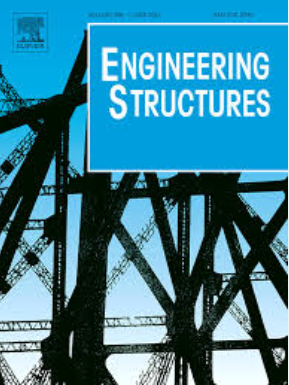浮动波能转换器混凝土桁架原型结构的研制:数字化设计、制造和抗弯性能
IF 6.4
1区 工程技术
Q1 ENGINEERING, CIVIL
引用次数: 0
摘要
波浪能将在创造平衡的陆上和海上可再生能源组合中发挥至关重要的作用。本文报道了一种可形成长度为3.5 m,直径为0.93 m的内部结构的预制混凝土空心桁架原型结构的设计、数值分析、制造和试验。设计的基础意味着只有两种形状的桁架成员被用来帮助更快的生产。锚定系统由钢榫接头和灌浆环氧树脂组成,以增加刚性和完整性。采用预制混凝土和预应力钢丝作为解决设计理念的尝试。对样机进行了单调弯曲载荷的物理和数值试验。观察到桁架在监测中环变形10 mm之前主要表现为弹塑性行为。确定了预制混凝土和构件的公差是导致桁架刚度响应减小的原因。采用自定义试验方法对环氧树脂及环氧树脂粘结锚的作用机理进行了研究。数值模拟揭示的应力分布特征表明,段与段之间的连接暴露在较高的抗拉强度下,可能导致混凝土开裂。结果表明,环氧树脂粘结锚固的存在及其对桁架完整性的影响是导致桁架破坏的主要原因。本文章由计算机程序翻译,如有差异,请以英文原文为准。
Development of a concrete prototype truss structure for floating wave energy converters: Digital design, manufacture and flexural performance
Wave energy will play a vital role in creating a balanced onshore and offshore renewable energy mix. This paper reports on the design, numerical analysis, manufacture and testing of a prototype precast concrete Vierendeel truss structure which could form the inner structure 3.5 m in length and 0.93 m in diameter. The basis for design meant that only two shapes of truss members were used to aid faster production. An anchoring system consisting of steel dowel connectors and grouted epoxy resin was used to increase rigidity and integrity. Precast concrete and steel wires for prestressing were used as the trial for addressing design concept. The prototype was tested being subjected to monotonic bending load physically and numerically. It was observed the truss mainly exhibited an elastoplastic behaviour before the deformation of 10 mm at the monitored middle ring. The tolerance of precast concrete and assembly were identified as causing the less stiff response of the truss. Mechanism of the epoxy and epoxy-bonded anchors was investigated using custom testing methods. The simulated stress distribution characteristics revealed by numerical modelling implicated that the connecting between segments was exposed to higher tensile strength causing potential concrete cracking. The presence of the epoxy-bonded anchoring and its influence to the integrity of the truss was identified as the source dominating the failure of the truss.
求助全文
通过发布文献求助,成功后即可免费获取论文全文。
去求助
来源期刊

Engineering Structures
工程技术-工程:土木
CiteScore
10.20
自引率
14.50%
发文量
1385
审稿时长
67 days
期刊介绍:
Engineering Structures provides a forum for a broad blend of scientific and technical papers to reflect the evolving needs of the structural engineering and structural mechanics communities. Particularly welcome are contributions dealing with applications of structural engineering and mechanics principles in all areas of technology. The journal aspires to a broad and integrated coverage of the effects of dynamic loadings and of the modelling techniques whereby the structural response to these loadings may be computed.
The scope of Engineering Structures encompasses, but is not restricted to, the following areas: infrastructure engineering; earthquake engineering; structure-fluid-soil interaction; wind engineering; fire engineering; blast engineering; structural reliability/stability; life assessment/integrity; structural health monitoring; multi-hazard engineering; structural dynamics; optimization; expert systems; experimental modelling; performance-based design; multiscale analysis; value engineering.
Topics of interest include: tall buildings; innovative structures; environmentally responsive structures; bridges; stadiums; commercial and public buildings; transmission towers; television and telecommunication masts; foldable structures; cooling towers; plates and shells; suspension structures; protective structures; smart structures; nuclear reactors; dams; pressure vessels; pipelines; tunnels.
Engineering Structures also publishes review articles, short communications and discussions, book reviews, and a diary on international events related to any aspect of structural engineering.
 求助内容:
求助内容: 应助结果提醒方式:
应助结果提醒方式:


